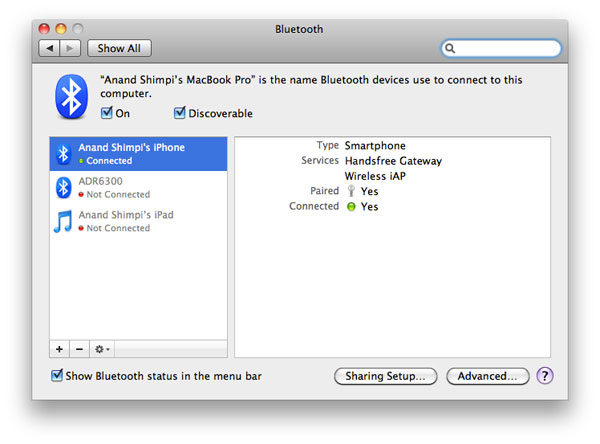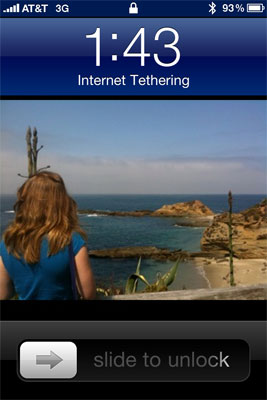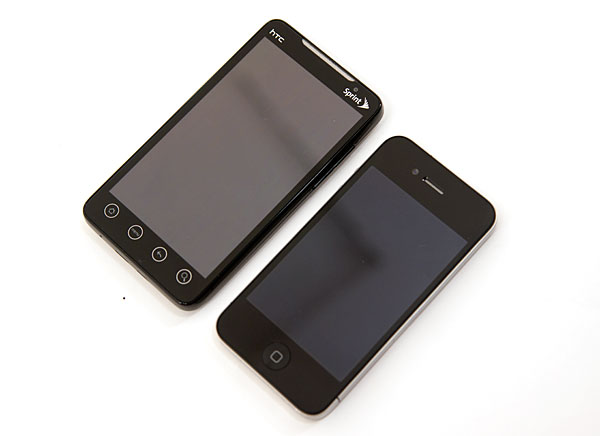Apple's iPhone 4: Thoroughly Reviewed
by Brian Klug & Anand Lal Shimpi on June 30, 2010 4:06 AM EST- Posted in
- Smartphones
- Apple
- iPhone 4
- Gadgets
- Mobile
Living with the 4
Thus far the majority of this article has focused on the technical details of the new iPhone both in its advancements and shortcomings, but what is it like to live with?
As I implied in the introduction, the 4 makes the previous iPhone feel very old. But in day to day use it doesn’t feel much different. It uses the same iOS that iPhone 3GS users get access to so with the exception of FaceTime and camera improvements, the iPhone 4 is functionally the same as its predecessor. That’s an important thing to keep in mind because to a 3GS owner it makes the iPhone not feel any different.

We've already covered iOS 4 extensively so there's no point in rehashing that here. The only new experience we have to add is our time with tethering.
The option to enable tethering is unfortunately buried in iOS 4's settings. You need to go into general settings, then network and then Internet tethering. You also need to either have Bluetooth enabled or be connected via USB to the computer you wish to tether.

You of course need to have tethering enabled on your plan, which you can't do from the settings menu. You either have to call AT&T or add the plan via attwireless.com. From there just connect to the 4 and you can use it as a modem. The phone can even be locked while tethered. Once enabled it ranges from a lifesaver to a total waste of money depending on AT&Ts coverage.

Getting used to the size of the new iPhone isn't hard at all. The device is a lot thinner which makes two handed portrait operation more strenuous especially if you're typing a lot on it. The 4 is going to be one great gaming device because holding it in landscape mode feels awesome. Overall I'd say the size feels right.
The glass everywhere is nice. It does make it impossible to quickly tell which side is front when you're fumbling around your pocket looking for it though. And I still feel like I'm going to drop and break the thing in no time at all. While not as slick as the 3GS' plastic, the stainless steel and glass aren't exactly the most grippy surfaces.
The higher res screen makes even sending text messages clearer. Everything is just so much more crisp.

Browsing the web is more pleasant as well, but tiny text is still tiny text regardless of how sharp the display is. You'll still need to zoom in on regular sites.
You do get used to the screen though. It's only when going back to the 3GS that the 4 feels new again. It's sort of like an SSD, you miss the retina display when it's gone.
The seat of the pants feel has definitely improved thanks to the A4. Although, I'd say its subtle. Web pages load quicker, animations are smoother. It's not perfect however. There are still some choppy animations and pauses from the scheduler giving too much CPU time to a hungry process. In general though, the phone feels like it was designed to run iOS 4 while the 3GS can get a bit overwhelmed at times.

The OS improvements, although not specific to the 4, are still lacking in two key areas. Apple still hasn't implemented a good notification system ala Android or webOS. I expected that update with iOS 4 but I guess we'll get it next year instead.
Secondly the multitasking interface is nice but still not quite perfect. I am still holding out for either an improved webOS or for Apple to do it's own take on the card system.
How does the 4 compare to Android? The same differences are still there. Currently there is no Android phone quite as sleek as the iPhone 4, although I expect that could change in less than a year.
The latest Android phones have had better cameras and higher resolution screens, so the iPhone 4 doesn't have as huge of an advantage there.
Apple still has the UI polish down pat. Scrolling is far smoother and performance more consistent, although I believe Google isn't far away from fixing this. The Froyo update alone does wonders to performance. If Google could fix the scrolling issues I'd say a number of iPhone users would for sure be fine with switching.

There is this more open, more configurable, more capable feel you get with Android that you don't with the iPhone. That can be both a positive and a negative. Android phones feel more like computers while iPhones have more of that appliance feel. It still boils down to personal preference, the 4 won't change that.










270 Comments
View All Comments
Lemurion - Friday, July 2, 2010 - link
I was disappointed that you they only compared the iPhone 4 screen to the 800 by 480 AMOLED screens on some of the Android devices. As far as I know, all those devices use the Pentile system, which reduces the crispness of text.I would have really liked to compare the new Apple screen to the Motorola Droid's 266 PPI screen and see how noticeable the difference there was.
Matt Campbell - Friday, July 2, 2010 - link
Nice investigation work on the signal strength. Just wanted to point out that AnandTech is cited in the Apple iPhone 4 software fix story on CNN today. http://www.cnn.com/2010/TECH/mobile/07/02/apple.ip...Bad Bimr - Friday, July 2, 2010 - link
http://www.cnn DOT com/2010/TECH/mobile/07/02/apple.iphone.apology/index.htmlJust like apple, finally admitting a problem, pleasing the fan boys by saying it will be addressed and doing nothing to fix it. I am so glad I never jumped on the apple bandwagon.
fischerm83 - Friday, July 2, 2010 - link
So i was reading various news articles today and saw that apple finally figured out/admitted to what you guys found out earlier this week...*quote*
Now the company says its engineers have made a "stunning" discovery. Reception is poor and calls may be dropped because not only are people holding the phone wrong, but they also think they have a better signal than they do. In the statement, Apple says that it has made a mistake in the formula that calculates the number of bars that display the signal strength on all of its iPhones.
"We were stunned to find that the formula we use to calculate how many bars of signal strength to display is totally wrong," it said in a statement.
*quote*
Full Article:
http://news.cnet.com/8301-30686_3-20009564-266.htm...
Nice work guys, keep up the amazing work!
anandreader - Friday, July 2, 2010 - link
Brian-I'm confused as to what had to happen to get Fieldtest onto the iphone 4. Understood the bit about jailbreaking the iphone3 but didn't understand how that information got transfered to the 4.
Could you elaborate a bit there?
Per Grenerfors - Friday, July 2, 2010 - link
Thanks for the great review, AnandTech.In countries where 3G coverages isn't spotty like a teenagers face, the whole antenna/at&t/verizon debate is just utterly unnecessary.
Apple is the only brand name in tech today that's recognized by the broader public. Their products therefore make a big splash in the media when they hit the market. But the bigger splash you make, the more mud comes floating up from the bottom. Like people complaining with a spec sheet in hand without ever having seen the device in real life. Or just plain old haters. This is the downside to fame. But I'm sure Apple's laughing all the way to the bank.
Stokestack - Friday, July 2, 2010 - link
A case isn't an acceptable workaround for this. I don't buy a thin phone to bulk it up and junk it up with a cheesy case or add-on of any kind.While I'm not planning on getting an iPhone 4, if I had one and wanted to keep it I'd try to spray a coating onto the antenna band. I'd mask the front & back, the buttons, and any seams, then spray with polyurethane or something. While it would be microscopically thin, there's be no direct contact with skin. And really, that's what you said you expected Apple to have done anyway. Let's see if it would work.
Excellent review. The hack to get the numeric signal strength rocks.
Fulle - Friday, July 2, 2010 - link
Thank you for the review. It was useful to be able to look at something that was detailed, and included facts, good and bad, without a ridiculous amount of bias. It's obvious that Anand likes, or at least really wants to like most Apple products, but it was nice that that didn't get in the way of the review.The new iPhone seems to be an OK device that's on par with new Android smartphones in way of hardware... The screen's got 20% higher pixel density than the Droid, but 50% worse contrast ratio, and worse black quality... Java performance is clearly inferior to a Nexus One, but browsing performance is competitive (I'd say good, but I think all handsets have shit browser performance). Its sleak and thin, but it has no hardware qwerty. The 5MP camera produces low noise, but, the white balance is messed up, making it overall inferior to the camera in a Nexus One or HTC Incredible (or Moto Droid, even, IMHO... screwed up over-saturated colors with bad white balance are a big deal to me). Overall, it's an average device when put up against worthy competition (EVO4G, DroidX, HTC Incredible, Nexus One, or even a Moto Droid).
But, that's before you have to deal with the obvious design flaws. Glass panels on both sides? WTF? Uninsulated external antenna? These aren't minor flaws here.
So, overall I'd say that the new iPhone is inferior to at least 6 Android smartphones.... and at first I grin at that... but then I'm disappointed and mad. Apple has helped make the smartphone market the competitive environment it is today, and when they drop the ball like this, it means that other venders don't have to raise the quality of their devices to compete. It's just fortunate that Android has so many hardware OEMs, like HTC, Samsung, and Motorolla, all competing with each other... or else I'd be afraid the only thing the iPhone4 would push in competition is a higher ppi on the screens.
Lets hope this helps push the Cortex-A9 equipped Android's this winter to include higher resolution in their displays... but, man, I'm disappointed with this device.
tgibbs - Friday, July 2, 2010 - link
Does zero dB represent a standard absolute signal strength or is it an arbitrary reference value that will differ for different phones?navderek - Saturday, July 3, 2010 - link
The signal is actually measured in dBm which means it is a reference to 1mW of power.For example -30dBm = 1000 times less that 1mW = 1uW
1 microwatt does not seem like much, but actually this is a very strong signal for the mobile and you would rarely have that much power arriving at your handset from the tower. In good conditions, close to the tower or serving antenna with minimal obstructions you could expect about -50 to -60 dBm (-60dBm = 1nW (nanowatt). The system is designed to deal with such small signals...this is why I laugh when people are worried about cell tower "radiation" when actually 5 min. in the sun is a bazzillion times more radiation than what's coming out of a tower....cellular towers that is, broadcast radio towers or paging systems are another story!
But I digress...to answer your question simply, zero dBm simple equals 1mW.
Zero dBm signifies that there is no difference in ratio from the reference of 1mW.